All cryogens are used near their boiling points. This means they are rapidly evolving gases at all times. The following shows both the extremely low boiling points of cryogens and the enormous amounts of gas these liquids could produce if they were to boil.
- Liquid Helium
- boiling point of 4.2 K, -269 C, -452 F
- volume ratio of liquid to warm gas is 1 : 757
- Liquid Nitrogen
- boiling point of 77.3 K, -196 C, -321 F
- volume ratio of liquid to warm gas is 1 : 696
Dewars are used to store and transport cryogenic liquids; gas boiloff is limited by keeping the liquid cold with thermal insulation and by allowing the volume to pressurize slightly. Dewars are protected against explosion by relief valves and burst disks. For a sobering account of what happens if such pressure relief is disabled, read
this. For a harrowing account of what happens if a dewar is damaged, read
this.
Liquid Helium (LHe)
LHe is used for equipment and experiments at very low temperatures (around 4-5 K). LHe cools the CTA magnet in the L0 blue room, CESR wiggler magnets, and superconducting RF cavities in CESR, ERL, and the HTC, as well as those at Newman Lab.
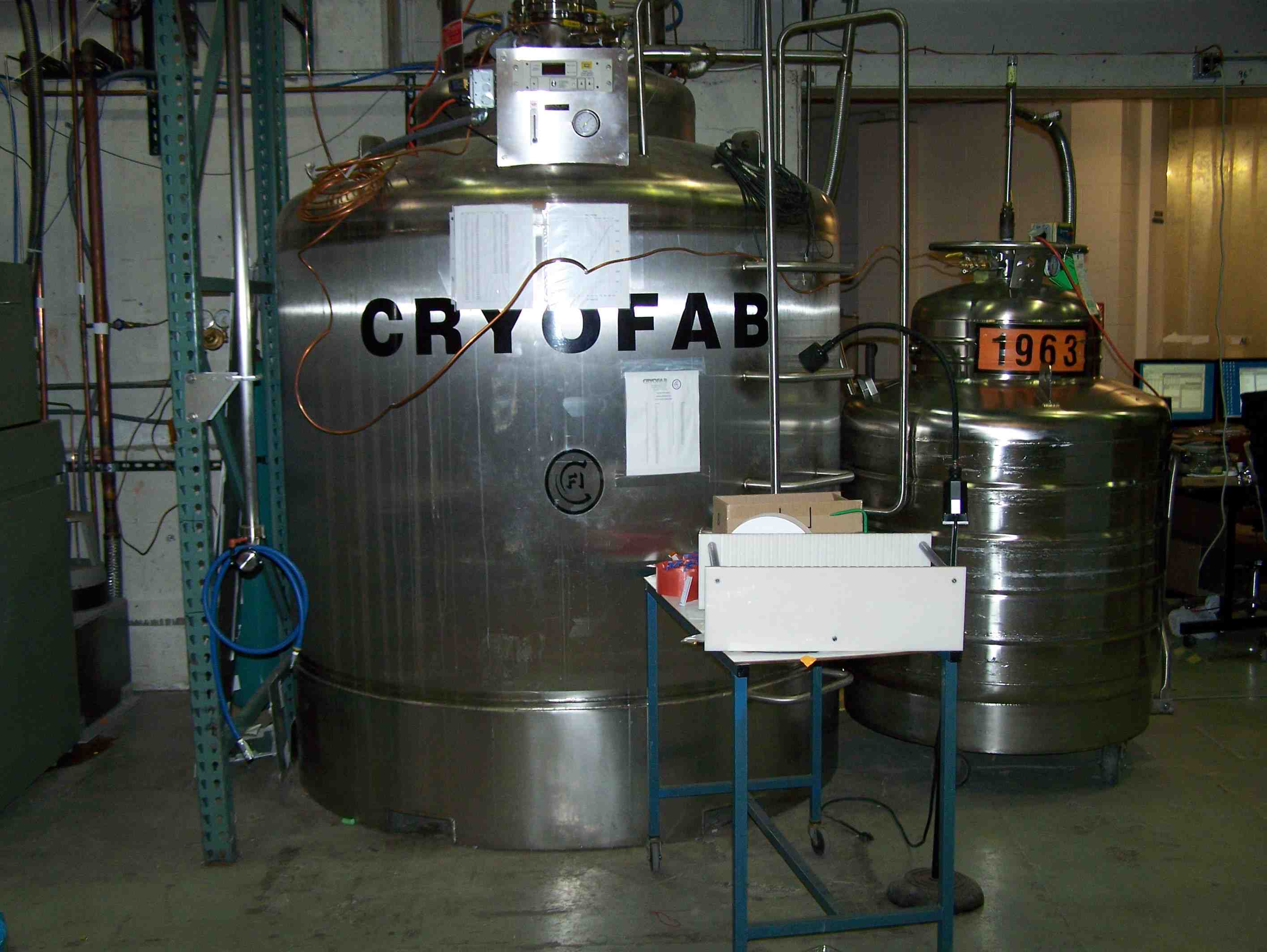
Like other cryogens, LHe is transported and stored in thermally insulated containers called
dewars. Never tip LHe dewars when transporting them. Always move slowly and pull them only by their handles, not by the protective ring around the top. If you must crane-lift a dewar, attach the cables to the lifting lugs only.
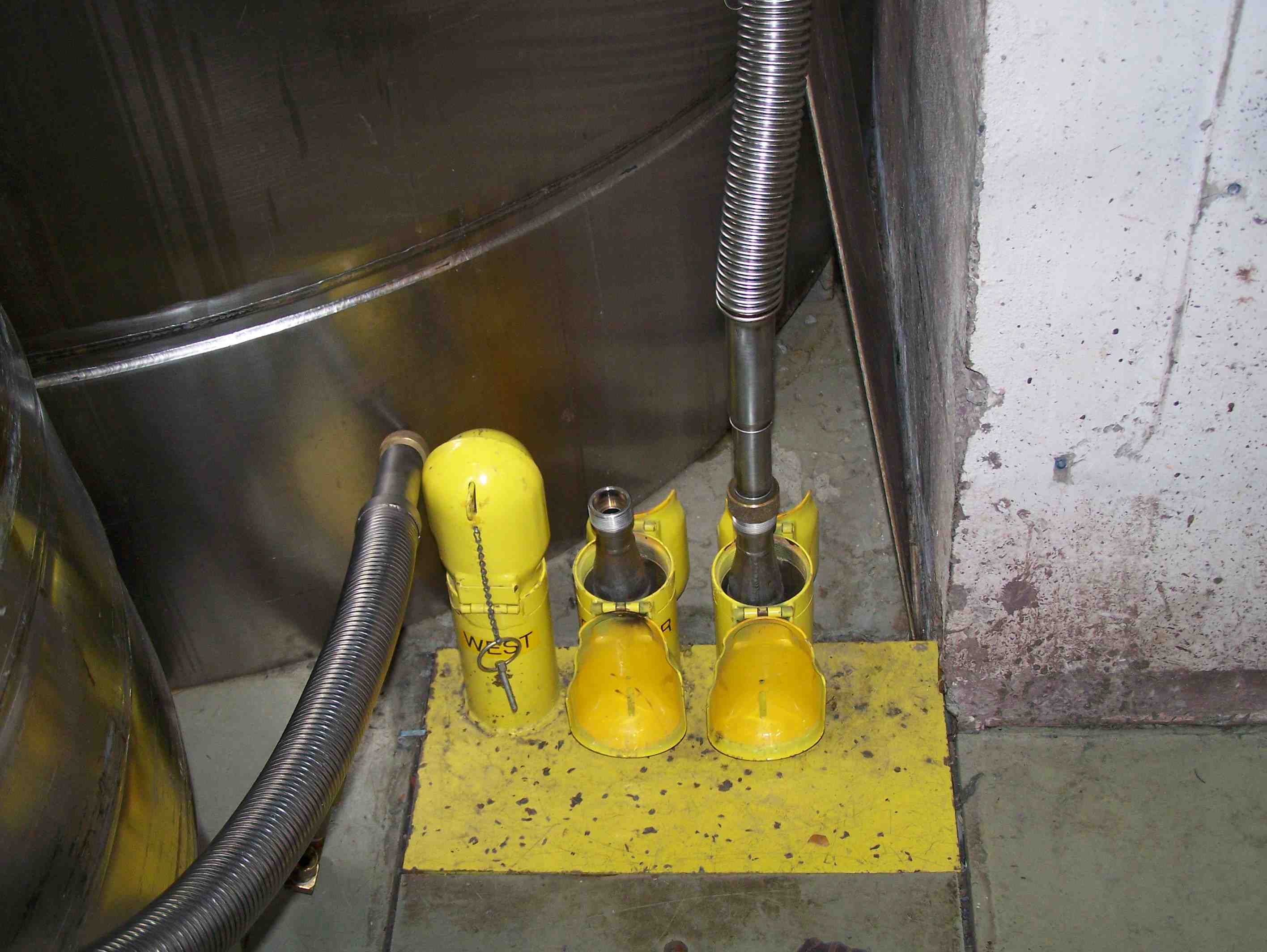
Transferring LHe requires detailed understanding of the procedure, including the use of vacuum-jacketed transfer lines, which can be quite cumbersome and awkward. You must receive on the job training by someone familiar with the transfer process before attempting a transfer.
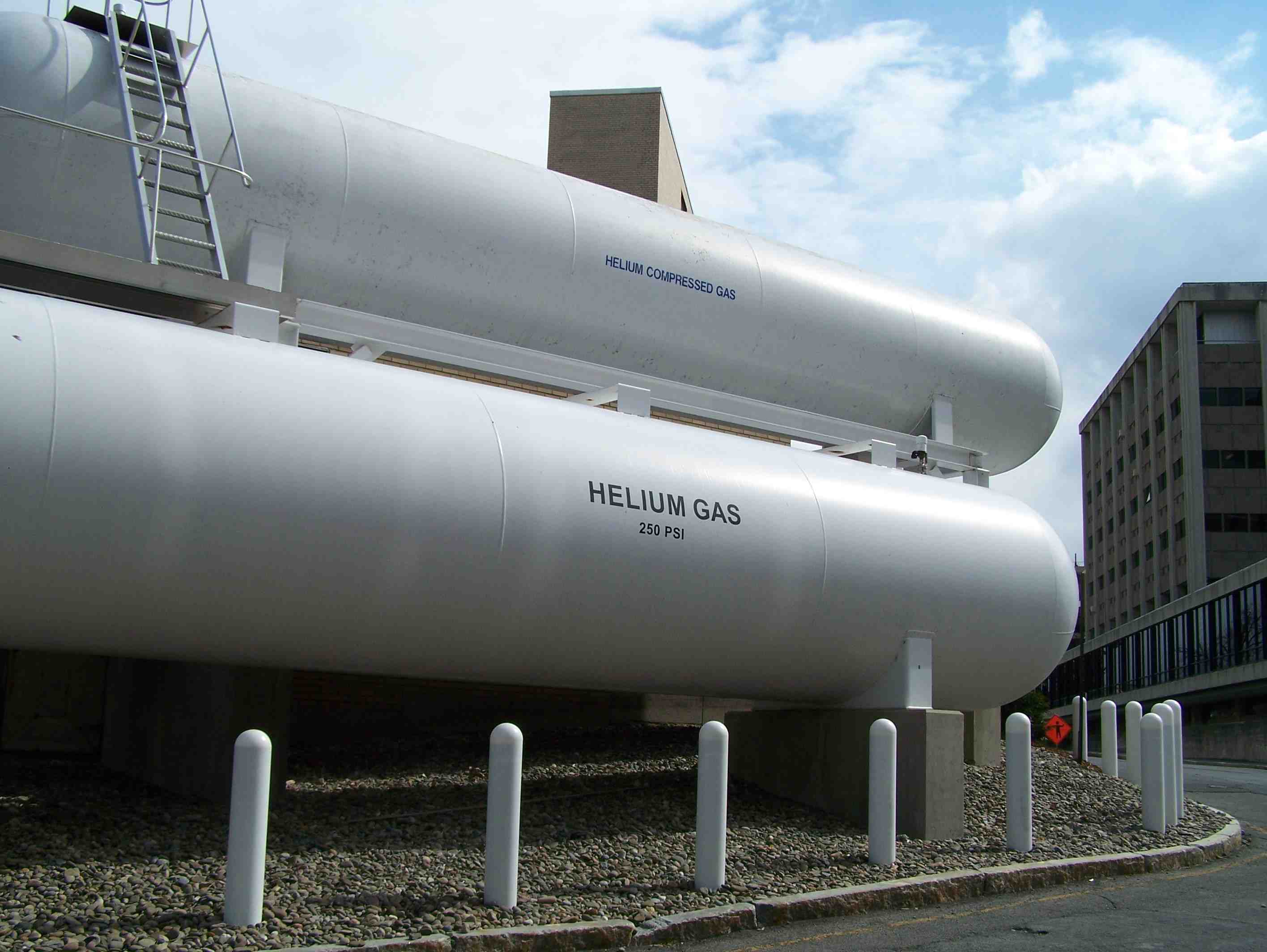
Both Wilson and Newman Laboratories have helium recovery/liquifaction systems which act to avoid helium loss by recooling evaporated helium into a liquid state. (In comparison, liquid nitrogen is relatively cheap, and no recovery system for nitrogen exists.) These systems contain refrigerators, large liquid helium reservoirs, liquid transfer lines, pumps, and large gaseous helium storage tanks which also act as a location for emergency pressure relief. These systems contain numerous safety features should be operated only by trained experts.
Liquid Nitrogen (LN2)
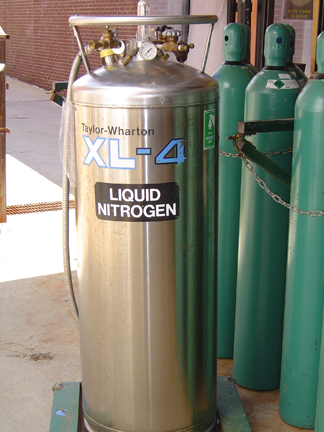
LN2 is sometimes used in the insulating jackets around LHe transfer lines and
dewars to prevent rapid evaporation of LHe by radiant heating. LHe boils at a temperature of about 4 K and has a latent heat of about 20 joules per gram, whereas LN2 boils at about 80 K and has a latent heat of about 200 joules per gram. Room temperature is about 300 K. LN2 cools the thermal barrier necessary between LHe and room temperature.
Full LN2 portable dewars weigh about 600 pounds. Use caution when using and transporting them. Transport and tip them only with approved handcarts that can support their full weight. You should receive instruction from someone familiar with the process before filling or transporting a dewar.
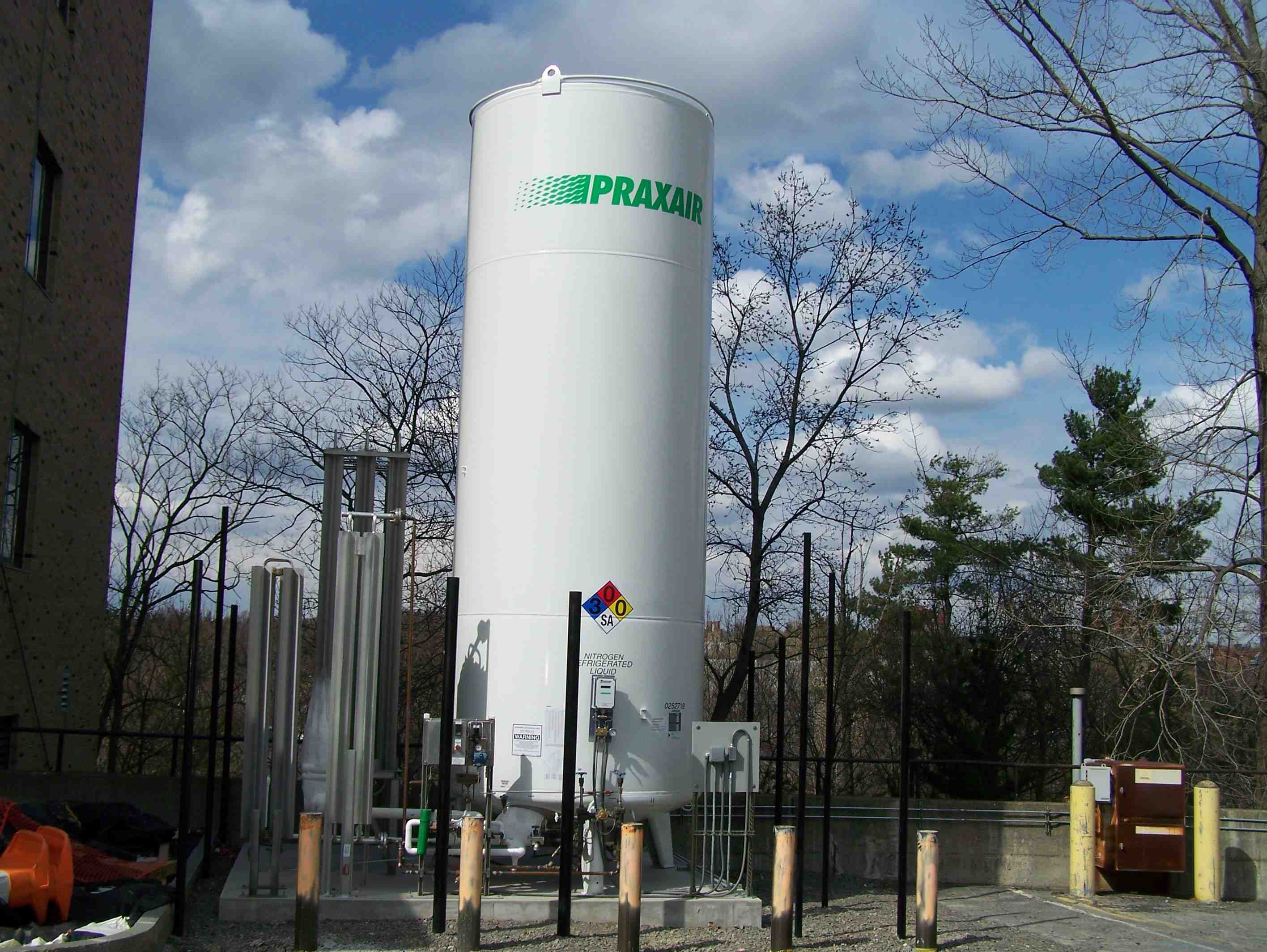
Whereas the cost of helium makes the CLASSE helium liquification and recovery economical, liquid nitrogen is purchased commercially and delivered to large storage tanks (emblazoned with the "PRAXAIR" logo) outside Newman and Wilson. Liquid from these tanks is then piped via insulated transfer lines

to the locations where large quantities are frequently or continuously needed. Small quantities of liquid N2 are sometimes useful, and small dewars can be filled by hand. Such filling requires the use of appropriate protective attire (see below).
Personal Protective Clothing
Avoid contact with cryogens or surfaces cooled to cryogenic temperatures to avoid cryogenic burns. Wear dry clothing when transporting or working near cryogens because the risk of cryogenic burns increases with wet skin or clothing. Wear long pants and long-sleeve shirts to avoid trapping any cryogens next to your body. You should also wear high-topped shoes, safety glasses or a face shield, and leather gloves. The gloves should be slightly large so you can remove them quickly in the event of a spill. Remove rings, watches, bracelets, and any other jewelry. Wear a waterproof tyvek suit, available in the stockroom, when there is a danger of being sprayed by cryogenic liquids.
If you are burned by a cryogen or a surface cooled to cryogenic temperatures, seek medical attention immediately (for anything other than minor burns, call 911). While waiting for help to arrive, bathe the burned skin with warm, not hot, water. Remember that the skin may be both frozen and burned.
Cryogens and Oxygen Depletion
Modest volumes of liquefied gases can displace much larger volumes of air when heated suddenly, leaving the air with a reduced oxygen supply. For this reason it is important to review the hazard in a given room or lab where cryogens are used and engineer appropriate safeguards. Examples where engineered controls were required include the liquid helium and liquid nitrogen used in the CESR tunnels and in the Newman SRF Processing Pits. Whenever cryogens are used in labs, rooms or other restricted volume areas, the volume of the cryogen used and the maximum delivery rate need to be compared to the volume of the use area and its ventilation rate. A simple summary should be discussed with the Safety Director.
Although the details of the use of cryogens are usually evaluated when there is a system design, there are guidelines that should be observed from the beginning of the design and included in the
Safety Plan. Some of these include
- All normal exhausts of evaporated cryogens are vented outside the building or into a large, well-ventillated volume such as L0 at Wilson Lab
- Stored volumes and supply rates are limited to only what is needed
- All reasonably anticipated events that result in a venting of cryogen are engineered to vent outside the limited volume area. These would include quenches, simple vacuum failures, simple operational errors, and warm ups. This is usually accomplished by having a set of pressure relief systems that discharge into an appropriately sized and engineered vent line
- There is adequate ventilation
- Cryogenic storage vessels and delivery lines are protected against casual damage
- No trapped cryogenic volumes
Other Cryogenic Hazards
Cryostats are insulated containers that help maintain equipment at cryogenic temperatures. Each must be equipped with an adequate pressure relief system on any closed volume such as the insulating vacuum, any LN2 jacket, and the LHe vessel. Maximum working pressure of the cryostat must not be exceeded. Some dewars and cryostats use flexible "pigtails" which must be secured to prevent them from whipping around while cryogens are first being transferred through them.
Surprisingly, LHe and LN2, which are not flammable in their natural states, can pose fire hazards as cryogens. Because cryogens are so cold, they can cause oxygen from the surrounding air to condense on transfer lines as they flow through them. Concentrated oxygen is a fire hazard, so use insulated transfer lines to prevent condensation.
 Safety/Handbook Web
Safety/Handbook Web
 Create New Topic
Create New Topic
 Index
Index
 Search
Search
 Changes
Changes
 Notifications
Notifications
 RSS Feed
RSS Feed
 Statistics
Statistics
 Preferences
Preferences
 ACC
ACC
 ACL
ACL
 Bunch
Bunch
 Private
Private
 BusinessOffice
BusinessOffice
 CBB
CBB
 NSF
NSF
 CBETA
CBETA
 CESR
CESR
 Private
Private
 CHESS
CHESS
 FMB
FMB
 Maia
Maia
 XIMG
XIMG
 CHEXS
CHEXS
 CLASSE
CLASSE
 Inventory
Inventory
 Communications
Communications
 CLEO
CLEO
 AC
AC
 Administration
Administration
 RunMan
RunMan
 SW
SW
 CMSPhase2MREFC
CMSPhase2MREFC
 Computing
Computing
 Blogs
Blogs
 Newsletter
Newsletter
 Obsolete
Obsolete
 Cosmology
Cosmology
 Private
Private
 DarkPhoton
DarkPhoton
 ERL
ERL
 Private
Private
 EngineeringDesignDrafting
EngineeringDesignDrafting
 G2
G2
 HEP
HEP
 DBSWorkshop
DBSWorkshop
 SWIG
SWIG
 HLLHCCMSMREFC
HLLHCCMSMREFC
 HMF
HMF
 HumanResources
HumanResources
 Private
Private
 ILC
ILC
 Americas
Americas
 CesrTA
CesrTA
 Proposal
Proposal
 DampingRings
DampingRings
 AreaLeaders
AreaLeaders
 CTA09
CTA09
 ILCDR06
ILCDR06
 ILCDR07_KEK
ILCDR07_KEK
 ILCDR08
ILCDR08
 S3TaskForce
S3TaskForce
 Private
Private
 CesrTA
CesrTA
 WWS
WWS
 MacCHESS
MacCHESS
 Main
Main
 People
People
 PhotocathodeBrightBeams
PhotocathodeBrightBeams
 REU
REU
 Private
Private
 SRF
SRF
 PCsrfcn1
PCsrfcn1
 Safety
Safety
 Handbook
Handbook
 Private
Private
 ExternalResources
ExternalResources
 Sandbox
Sandbox
 TestWeb
TestWeb
 Testauth
Testauth
 System
System
 Theory
Theory
 Communications
Communications
 Documents
Documents
 Phase2MREFC
Phase2MREFC
 WebDev
WebDev
 Private
Private
 XLEAP
XLEAP
 Copyright © by the contributing authors. All material on this collaboration platform is the property of the contributing authors.
Copyright © by the contributing authors. All material on this collaboration platform is the property of the contributing authors. 



 Like other cryogens, LHe is transported and stored in thermally insulated containers called
Like other cryogens, LHe is transported and stored in thermally insulated containers called  Transferring LHe requires detailed understanding of the procedure, including the use of vacuum-jacketed transfer lines, which can be quite cumbersome and awkward. You must receive on the job training by someone familiar with the transfer process before attempting a transfer.
Transferring LHe requires detailed understanding of the procedure, including the use of vacuum-jacketed transfer lines, which can be quite cumbersome and awkward. You must receive on the job training by someone familiar with the transfer process before attempting a transfer.
 Both Wilson and Newman Laboratories have helium recovery/liquifaction systems which act to avoid helium loss by recooling evaporated helium into a liquid state. (In comparison, liquid nitrogen is relatively cheap, and no recovery system for nitrogen exists.) These systems contain refrigerators, large liquid helium reservoirs, liquid transfer lines, pumps, and large gaseous helium storage tanks which also act as a location for emergency pressure relief. These systems contain numerous safety features should be operated only by trained experts.
Both Wilson and Newman Laboratories have helium recovery/liquifaction systems which act to avoid helium loss by recooling evaporated helium into a liquid state. (In comparison, liquid nitrogen is relatively cheap, and no recovery system for nitrogen exists.) These systems contain refrigerators, large liquid helium reservoirs, liquid transfer lines, pumps, and large gaseous helium storage tanks which also act as a location for emergency pressure relief. These systems contain numerous safety features should be operated only by trained experts.
 LN2 is sometimes used in the insulating jackets around LHe transfer lines and
LN2 is sometimes used in the insulating jackets around LHe transfer lines and  Whereas the cost of helium makes the CLASSE helium liquification and recovery economical, liquid nitrogen is purchased commercially and delivered to large storage tanks (emblazoned with the "PRAXAIR" logo) outside Newman and Wilson. Liquid from these tanks is then piped via insulated transfer lines
Whereas the cost of helium makes the CLASSE helium liquification and recovery economical, liquid nitrogen is purchased commercially and delivered to large storage tanks (emblazoned with the "PRAXAIR" logo) outside Newman and Wilson. Liquid from these tanks is then piped via insulated transfer lines to the locations where large quantities are frequently or continuously needed. Small quantities of liquid N2 are sometimes useful, and small dewars can be filled by hand. Such filling requires the use of appropriate protective attire (see below).
to the locations where large quantities are frequently or continuously needed. Small quantities of liquid N2 are sometimes useful, and small dewars can be filled by hand. Such filling requires the use of appropriate protective attire (see below).
